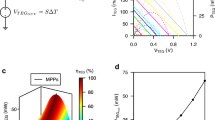Abstract
We present a simple implementation of a thermal energy harvesting circuit with the maximum power point tracking (MPPT) control for self-powered miniature-sized sensor nodes. Complex start-up circuitry and direct current to direct current (DC-DC) boost converters are not required, because the output voltage of targeted thermoelectric generator (TEG) devices is high enough to drive the load applications directly. The circuit operates in the active/asleep mode to overcome the power mismatch between TEG devices and load applications. The proposed circuit was implemented using a 0.35-μm complementary metal-oxide semiconductor (CMOS) process. Experimental results confirmed correct circuit operation and demonstrated the performance of the MPPT scheme. The circuit achieved a peak power efficiency of 95.5% and an MPPT accuracy of higher than 99%.
Similar content being viewed by others
References
Arsalan M, Ouda MH, Marnat L, et al., 2013. A 5.2GHz, 0.5mW RF powered wireless sensor with dual on-chip antennas for implantable intraocular pressure monitoring. IEEE MTT-S Int Microwave Symp, p.1–4. https://doi.org/10.1109/MWSYM.2013.6697639
Belleville M, Fanet H, Fiorini P, et al., 2010. Energy autono-mous sensor systems: towards a ubiquitous sensor tech-nology. Microelectron J, 41(11):740–745. https://doi.org/10.1016/j.mejo.2010.01.009
Carlson EJ, Strunz K, Otis BP, 2010. 20 mV input boost con-verter with efficient digital control for thermoelectric energy harvesting. IEEE J Sol-State Circ, 45(4):741–750. https://doi.org/10.1109/JSSC.2010.2042251
Chen PH, Ishida K, Ikeuchi K, et al., 2011a. A 95 mV-startup step-up converter with Vth-tuned oscillator by fixed-charge programming and capacitor pass-on scheme. IEEE Int Solid-State Circuits Conf, p.216–217. https://doi.org/10.1109/ISSCC.2011.5746290
Chen PH, Ishida K, Zhang X, et al., 2011b. A 80 mV input, fast startup dual-mode boost converter with charge-pumped pulse generator for energy harvesting. IEEE Asian Solid-State Circuits Conf, p.33–36. https://doi.org/10.1109/ASSCC.2011.6123562
Cheng MH, Wu ZW, 2005. Low-power low-voltage reference using peaking current mirror circuit. Electron Lett, 41(10):572–573. https://doi.org/10.1049/el:20050316
Colomer-Farrarons J, Miribel-Catala P, Saiz-Vela A, et al., 2008. Power-conditioning circuitry for a self-powered system based on micro PZT generators in a 0.13 µm low-voltage low-power technology. IEEE Trans Ind Electron, 55(9):3249–3257. https://doi.org/10.1109/TIE.2008.927973
Doms I, Merken P, Hoof CV, et al., 2009. Capacitive power management circuit for micropower thermoelectric gen-erators with a 1.4 µA controller. IEEE J Sol-State Circ, 44(10):2824–2833. https://doi.org/10.1109/JSSC.2009.2027546
Im JP, Wang SW, Lee KH, et al., 2012. A 40 mV transformer-reuse self-startup boost converter with MPPT control for thermoelectric energy harvesting. IEEE J Sol-State Circ, 47(12):3055–3067. https://doi.org/10.1109/JSSC.2012.2225734
Jang JH, Berdy DF, Lee JJ, et al., 2013. A wireless condition monitoring system powered by a sub-100 µW vibration energy harvester. IEEE Trans Circ Syst, 60(4):1082–1093. https://doi.org/10.1109/TCSI.2012.2215395
Kausar ASMZ, Reza AW, Saleh MU, et al., 2014. Energizing wireless sensor networks by energy harvesting systems: scopes, challenges and approaches. Renew Sustain En-ergy Rev, 38:973–989. https://doi.org/10.1016/j.rser.2014.07.035
Kim HS, Kim GH, Lee YM, et al., 2015. A 10.6 mm3 fully-integrated, wireless sensor node with 8GHz UWB transmitter. Symp on VLSI Circuits, p.202–203. https://doi.org/10.1109/VLSIC.2015.7231258
Kim J, Kim C, 2013. A DC-DC boost converter with variation tolerant MPPT technique and efficient ZCS circuit for thermoelectric energy harvesting applications. IEEE Trans Power Electron, 28(8):3827–3833. https://doi.org/10.1109/TPEL.2012.2231098
Kim RY, Lai JS, 2008. A seamless mode transfer maximum power point tracking controller for thermoelectric gener-ator applications. IEEE Trans Power Electron, 23(5): 2310–2318. https://doi.org/10.1109/TPEL.2008.2001904
Lee YM, Bang SY, Lee IH, et al., 2013. A modular 1 mm3 die-stacked sensing platform with low power I2C inter-die communication and multi-modal energy harvesting. IEEE J Sol-State Circ, 48(1):229–243. https://doi.org/10.1109/JSSC.2012.2221233
Leonov V, Fiorini P, Sedky S, et al., 2005. Thermoelectric MEMS generators as a power supply for a body area network. 13th Int Conf on Solid-State Sensors, Actuators and Microsystems, p.291–294. https://doi.org/10.1109/SENSOR.2005.1496414
Lhermet H, Condemine C, Plissonnier M, et al., 2008. Efficient power management circuit: from thermal energy har-vesting to above-IC microbattery energy storage. IEEE J Sol-State Circ, 43(1):246–255. https://doi.org/10.1109/JSSC.2007.914725
Li W, Yao R, Guo L, 2009. A low power CMOS bandgap voltage reference with enhanced power supply rejection. 8th Int Conf on ASIC, p.300–304. https://doi.org/10.1109/ASICON.2009.5351450
Lu C, Tsui CY, Ki WH, 2011. Vibration energy scavenging system with maximum power tracking for micropower applications. IEEE Trans VLSI Syst, 19(11):2109–2119. https://doi.org/10.1109/TVLSI.2010.2069574
Mansano AL, Li YJ, Bagga S, et al., 2016. An autonomous wireless sensor node with asynchronous ECG monitoring in 0.18 µm CMOS. IEEE Trans Biomed Circ Syst, 10(3): 602–611. https://doi.org/10.1109/TBCAS.2015.2495272
Micropelt, 2018. Thin film Thermogenerator, MPG-D655. http://www.micropelt.com
Morimura H, Oshima S, Matsunaga K, et al., 2014. Ultra-low-power circuit techniques for mm-size wireless sensor nodes with energy harvesting. IEICE Electron Exp, 11(20):1–12. https://doi.org/10.1587/elex.11.20142009
Ramadass YK, Chandrakasan AP, 2011. A battery-less ther-moelectric energy harvesting interface circuit with 35 mV startup voltage. IEEE J Sol-State Circ, 46(1):333–341. https://doi.org/10.1109/JSSC.2010.2074090
Seeman MD, Sanders SR, Rabaey JM, 2008. An ultra-low-power power management IC for energy-scavenged wireless sensor nodes. IEEE Power Electronics Specialists Conf, p.925–931. https://doi.org/10.1109/PESC.2008.4592048
Strasser M, Aigner R, Lauterbach C, et al., 2003. Micro-machined CMOS thermoelectric generators as on-chip power supply. 12th Int Conf on Solid-State Sensors, Ac-tuators and Microsystems, p.45–48. https://doi.org/10.1109/SENSOR.2003.1215249
Weng PS, Tang HY, Ku PC, et al., 2013. 50 mV-input bat-teryless boost converter for thermal energy harvesting. IEEE J Sol-State Circ, 48(4):1031–1041. https://doi.org/10.1109/JSSC.2013.2237998
Yoon EJ, Yu CG, 2016. Power management circuits for self-powered systems based on micro-scale solar energy har-vesting. Int J Electron, 103(3):516–529. https://doi.org/10.1080/00207217.2015.1036802
Zhang Y, Zhang F, Shakhsheer Y, et al., 2013. A batteryless 19 µW MICS/ISM-band energy harvesting body sensor node SoC for ExG applications. IEEE J Sol-State Circ, 48(1):199–213. https://doi.org/10.1109/JSSC.2012.2221217
Author information
Authors and Affiliations
Corresponding author
Additional information
Project supported by the Incheon National University Research Grant in 2015 and partly supported by IDEC
Rights and permissions
About this article
Cite this article
Yoon, EJ., Park, JT. & Yu, CG. Thermal energy harvesting circuit with maximum power point tracking control for self-powered sensor node applications. Frontiers Inf Technol Electronic Eng 19, 285–296 (2018). https://doi.org/10.1631/FITEE.1601181
Received:
Accepted:
Published:
Issue Date:
DOI: https://doi.org/10.1631/FITEE.1601181
Key words
- Thermoelectric energy
- Energy harvesting
- Maximum power point tracking (MPPT) control
- Self-powered system
- Sensor node




